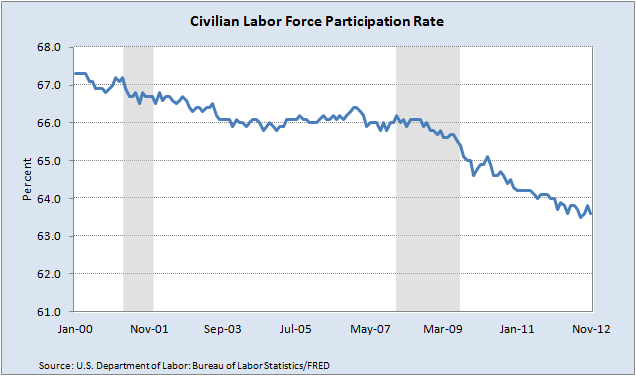The job market in November performed notably better than expected, especially in light of expected damage to hiring from late October’s Hurricane Sandy.
The Bureau of Labor Statistics reported that payrolls grew by 146,000 last month and unemployment ticked down to 7.7%, the lowest rate since late 2008. That decline, however, was once again driven by labor force withdrawal, so it should not be taken as a sign of a tighter job market.
Analysts were expecting the impact of the storm on the most densely-packed labor markets in the country to significantly lower the job count. But the Bureau reported that their survey response rates in the affected states were in the normal range, so they don’t believe Sandy is “substantively” distorting these numbers.
Construction data may, however, reveal some storm-related effects, with jobs off 20,000 in November after growing slightly in prior months as the housing market has begun to show signs of life (we’ll have to wait for the state data release later in the month to see if the losses were in affected states).
Downward revisions took 49,000 jobs off of the September and October payroll counts, so, factoring in today’s report, the average pace of payroll growth over the past three months is about 140,000 overall and 150,000 in the private sector. That pace is consistent with an economy growing at a decent clip and with a slowly declining unemployment rate. It is not, however, fast enough job growth to quickly reduce the large gaps in output, employment, and earnings that continue to hold back working families.
A few details:
–Average weekly hours held steady, another unexpectedly positive result given Sandy’s impact.
–I’ve been closely watching the wage gauges for evidence that the persistently high unemployment rate is continuing to hack away at wage growth. Today’s numbers show nominal wages of middle-wage workers growing only 1.3%, year-over-year, an historically very low rate and well behind inflation, which is running above 2%–so real paychecks are declining for many in the workforce.
–Manufacturing was down slightly (-7,000) though auto production added 10,000 jobs. While factory sector employment has been flat over the past few months, it’s still up 174,000 over the last year.
–Though labor force and employment data from the household survey were negative in November, those are partly “give-backs” from positive outliers in prior months. The fact that the participation rate—the share of the working-age population either working or looking for work—is down from last year (63.6% last month versus 64% a year ago; see figure below) and continuing on a negative trajectory is a sign of continued labor market weakness (it also reflects retiring boomers, but the cyclical component explains at least half of the decline).
In sum, the good news is that Sandy doesn’t appear to have disrupted work as much as we thought and that payrolls continue to expand at a steady pace. The less-good news is that the pace of job growth remains too slow to quickly bring down the jobless rate, pull more folks back into the job market, and give workers’ paychecks a much-needed boost.


